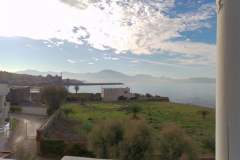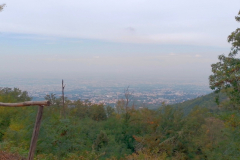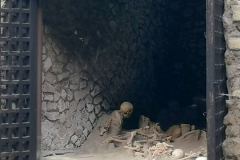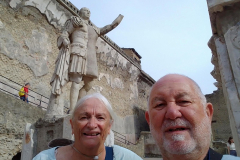Naples, Versuvius, Pompeii
Having left Greece by Ferry we landed in Bari, Italy the next morning. Travelling by train on to Naples we were just out of the city of Naples when we got our first sighting of the famous Mt Versuvius. Our plans had us climbing to the top the next day but for now our hotel was our goal.
Puntaquattroventi
One of the things about booking hotels online is that you don’t always get what you expect and this stay was the perfect example of that. The Hotel Puntaquantroventi was well south of Naples on the slopes of Versuvius. As a consequence we actually didn’t get to see Naples except out of the window of a taxi. This location though didn’t bother us because the hotel was exceptional. It has all the facilities you’d want including a private beach. The staff was terrific as was the restaurant food and the sunsets were glorious. The only drawback was the isolation meant we needed taxis to get anywhere.
Versuvius and Pompeii
One day we took a combined tour of Versuvius and Pompeii. There was just 4 of us on the tour. Shane sat out the climb to the top I and my 2 new Pommie friends set off in the cool air. I can promise you that we weren’t cool for long. It’s not a monsterous climb but it does tax the lungs and heart a bit. The views from the top are splendid looking over Sorrento to the south. Happily, Versuvius is not violently active however there are vents that expel volcanic gas into the atmosphere. I enjoyed the walk but after our Monastery walk in Northern Greece my legs were aching.
Following a lunch break our next stop was the doomed city of Pompeii. Our guide, Raphael, was extremely knowledgeable (he speaks 5 languages fluently) and he entertained us with information in a humerous manner that had us laughing constantly. Like Herculaneum (next section) the frescos and reliefs are magnificent but the (ghoulish) high point is the exhibit of bodies as they were found covered in lava. From the display of bodies we walked to the town arena before ending our tour at the Odeon Theatre.
The last 6 photos are of the nearby town of Torre Del Greco. I promised the owner of the shoe shop that I’d put a photo of his shop in the blog after he supplied Shane with a good pair of sandals at a great price saving us from the torturous shop to shop search we normally have to undertake.
Herculanium
If I didn’t sound overly excited by Pompeii it is because the day before Shane and I took ourselves out to nearby Ercolano to visit the lesser known ruins of Herculanium. It came as a shock to us to see the gates right in the centre of the town as if it was nothing special. In fact much of present Ercolano is built over the top of much of the ancient city.
The day of the fateful eruption (source https://www.pompeiitours.it/blog/pompeii-vs-herculaneum-whats-the-difference/)
Pompeii and Herculaneum experienced the eruption of 79 AD in very different ways. This led to varying degrees of preservation and a vast difference in the numbers of survivors.
There were two main stages in the eruption of Mount Vesuvius. In the first phase, a huge column of volcanic ash, gas, and rock shot high into the air and then began to rain down from the sky. Because the wind was blowing in a south-easterly direction, this rain of pumice rocks fell over the town of Pompeii, injuring the inhabitants, trapping them in buildings and causing other buildings to collapse. Herculaneum survived this phase, potentially allowing many residents to escape before the more destructive second stage of eruption.
The second stage featured pyroclastic flows, fast-flowing rivers of gas and ash that cascade down the side of the volcano with intense speed and ferocity. These flows buried Pompeii under 4-6m of ash and covered Herculaneum in roughly 25m of ash.
What we ‘saw’
The first thing you notice at Herculanium is the depth of the ash that buried the city. Once through the gates you start down the pathway overlooking the ruins. You are then led through a tunnel that goes some way underground and comes out in the city streets. The first 6 photos after the tunnel entrance shows a grisly view of skeletons stacked aside in a space that once overlooked the beach. You can see the sand, converted to cement by the eruption, of a beachfront that is today some half a kilometer west of this location.
Because of the differing destructive behaviours of Versuvius, Herculanium displays more detail and less ruinous decay of the buildings. We were in awe of the colours in the surviving frescos. The mosaics both on the floors and walls are magnificent. Herculanium gives you a much better idea of life 2000 years ago.
After several hours of wandering the street in astonishment we exited via the suspension bridge and got one final photo of Herculaneum bathed in the red hues of another beautiful sunset.
That’s all for now
Well that’s another blog post done. As usual I am far behind but I am hopeful of catching up but in any case just keep your eyes open for more to come. I have Rome, Florence, Venice, Mantova to go and currently I’m in our room in Milan.
See you later
Garry and Shane.
















































